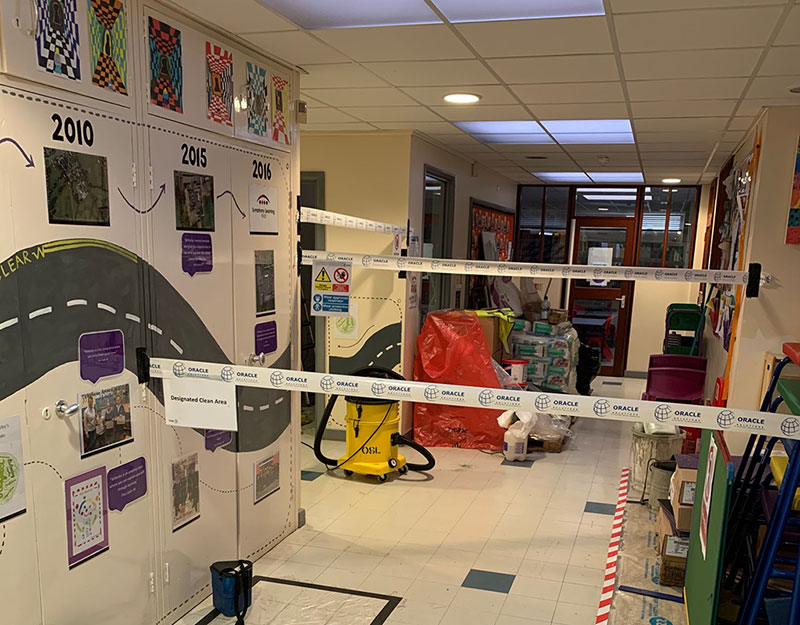Asbestos Flood Damage: Post-Disaster Procedures and Safety Measures
However, should asbestos materials be damaged, they can release dangerous microscopic fibres. When inhaled, those fibres stick to the lungs and can cause serious, life-threatening health issues years in the future.
When asbestos is damaged by a disaster like a fire or flood, it poses even more of a problem than usual.
First, a fire or flood makes it easier for asbestos fibres to be released into the air and contaminate the surroundings. A disaster of this scale can damage ACMs that weren’t at risk otherwise.
Additionally, these types of disasters make the building structure less secure. When floorboards, roofing and other structural elements are damaged, they have the potential to release asbestos. Moreover, they put workers in danger due to collapse.
Following a flood, it’s important to immediately contact an asbestos removal professional. Response time is critical when it comes to asbestos damage from a flood. At Oracle, we’re often able to respond within 2 hours.
The asbestos team will assess the situation, take surveys, communicate with the Health and Safety Executive (HSE) as needed, and come up with a plan of action.
Understanding Asbestos and Its Risks During Flooding
Before its dangers were fully understood, asbestos was used for insulation, fireproofing and strengthening in buildings across the UK. Common building materials and structural elements that include asbestos are:
- Adhesives
- Bath panels
- Brick
- Caulking
- Cement
- Concrete
- Cupboard walls
- Drain pipes
- Fireplaces
- Floor tiles
- Fuse boxes
- Garages
- Gutters
- HVAC systems
- Roofing
- Sheds
- Textured paints
While the use of asbestos has been banned in the UK since 1999, buildings that date back before that are likely to include asbestos.
Flooding can damage a building in areas where it wasn’t at risk of damage before. When these areas become damaged due to flooding, asbestos fibres are exposed and released.
For example, water can break down the bonding material in asbestos cement. Even if the cement wasn’t damaged previously, flooding could cause it to break apart and release asbestos fibres into the air.
Flooring is heavily affected by flooding, too. When flooring separates or swells, it must be removed by an asbestos professional.
Also, if waterproof asbestos fibres land on the surrounding water, they can sit on top of the water instead of sinking. When that water is disturbed by a cleanup process, the fibres can become airborne and be inhaled.
Safety Precautions During Initial Assessment
If your property has been damaged by a flood and it was built prior to 1999, you’ll need an experienced asbestos removal team to assess the situation.
Asbestos professionals experienced in emergency response will first inspect the area and take samples. They’ll look for signs of ACMs and determine where damage has occurred.
The Health and Safety Executive requires a 14-day Statutory Notification, which will be provided by the asbestos team.
They will then advise the property owner of the safest course of action to remove asbestos from the premises. Often, the goal is to reinstate the building as soon as possible so normal activities can continue.
In addition to asbestos fibre release, structural problems need to be considered after a flood. Certain areas of the building, like the roof and walls, are more prone to collapse when a flood has occurred.
Structural engineering consultants are typically part of the team that responds to these types of emergencies. They’re able to help the asbestos team come up with a safe plan of action.
Hiring a Licensed Asbestos Professional
In the aftermath of a flood, when ACMs may have been damaged, the risk assessment and cleanup should always be handled by an asbestos removal company with experience in flood emergencies. The preliminary assessment will include:
- Locating asbestos and determining its condition
- Finding out what type of asbestos is present and how much of it there is
- Deciding if work on the property will damage the asbestos more
Also note that the HSE will need to know if the asbestos contractors have taken the proper awareness training.
The individual in charge of the building is also responsible for asbestos management. Forgoing this duty, especially in a situation as dangerous as flooding, can result in legal issues, including fines and even jail time.
As the person with the duty to manage asbestos on your property, it’s up to you to vet the asbestos experts you hire. If they don’t have the proper training, don’t provide you with a refurbishment survey or fail to meet another requirement, the responsibility will fall on you.
Securing the Area and Implementing Safety Measures
Depending on how severe the flood was and the areas of the building that were impacted, some or all activities may have to stop during the cleanup process.
If the asbestos-affected part of the building can be safely sectioned off, it’s possible that activities can be temporarily relocated to safe areas. That was the case when Oracle handled an asbestos removal project in a school affected by flooding.
However, if it’s not possible to contain the asbestos damage, the building may have to be vacated until it’s safe to return.
The Asbestos Refurbishment Survey and Other Safety Measures
It’s important to remember that the HSE requires an asbestos refurbishment survey before work can proceed. Also, anyone involved in asbestos cleanup must utilise the proper protective gear. That includes the following:
Disposable protective clothing, including gloves, hats and overalls. The reason for disposable clothing is that regular clothing that’s been exposed to asbestos can’t be washed in a traditional machine, as it could cause more contamination.
Properly fitted respirators to protect against asbestos fibre inhalation.
Safe Asbestos Removal and Cleanup
Post-flood, wet building materials are often stripped out and dried. However, removing wet contents or stripping materials and drying them out can result in asbestos fibres being released. That’s why it’s so important that an asbestos survey takes place before these steps.
During the assessment stage, the asbestos team will have located the asbestos, assessed its condition and risk level, and come up with a plan to make the area safe again.
Here are a few best practices for asbestos cleanup:
- Damaged ACMs must be covered or sealed by an asbestos professional. This can be done by covering or sealing the ACM. Covering the ACM involves enclosing it with a protective wrap. Sealing the ACM involves using a sealant to coat the material so fibres can’t escape.
- Damaged ACMs that are going to be disposed of should be kept wet whenever possible to minimise dust going airborne.
- ACMs should not be broken up for easier handling. Asbestos fibres can release into the air when materials are broken up.
- All ACMs that are to be disposed of need to be placed in proper waste disposal bags and clearly labelled.
Also, a regular vacuum cleaner cannot be used to clean up asbestos dust and debris because it will cause fine fibres to go airborne. Instead, a HEPA filter vacuum is used.
Conducting Air Monitoring and Clearance Testing
Air testing and monitoring determine how much asbestos is present in a specific area. Specialty equipment is used to take an air sample, which is then analysed under a microscope.
Once your asbestos contractor decides that the area is ready for habitation again, a UKAS-accredited third party should come in to perform a four-stage clearance process. That includes:
- Checking the condition of the site.
- Visually inspecting the work area.
- Monitoring the air for asbestos fibres.
- Providing a final assessment of the work area.
Once finished, a clearance certificate will confirm the environment is safe.
Communicating with Residents
As a responsible building manager, residents and occupants should be aware of what’s happening:
- Let them know that asbestos is present and damaged, which could cause health hazards.
- Explain the risks of being exposed to asbestos.
- Provide guidelines about personal safety during and after cleanup.
- Let them know how to protect themselves from health risks.
- Offer support and resources for anyone who has an asbestos-related concern.
This communication isn’t intended to scare people or make them worry. Instead, it’s to provide them with information so they can take the proper steps to keep themselves safe.
It also lets them know that you’re aware of the situation and on top of handling it. When it is time to fully return to the building, they’ll be confident that they won’t be in danger.
Final Thoughts
Following a flood, many business owners and landlords want activities to return to normal as fast as possible. However, prior to refurbishment, asbestos must be dealt with. Otherwise, residents, visitors and workers are all at risk.
Only after an assessment, planning and removal by asbestos professionals can the property be safely worked on using moisture-extraction and air-blowing equipment.
Responsible asbestos management protects everyone’s health and safety during flood recovery. Contact us today if you’re dealing with an asbestos emergency.

Written by Brendan Coleman
Brendan Coleman, with decades of experience in the asbestos industry, is a dedicated Quality Manager. Certified as a surveyor and analyst, he is adept in operations and quality management with a keen focus on HSE compliance. His expertise is pivotal in maintaining high safety and efficiency standards. Brendan ensures our UKAS accreditation requirements are consistently met and exceeded, upholding stringent standards in asbestos remediation. His commitment to enhancing quality and customer satisfaction makes him an essential advisor in asbestos management.

